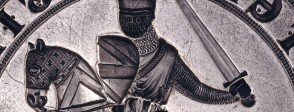Explore the seal with the students using the image in For the classroom. You could begin by asking who can make sense of the inscription around the edge and see how quickly the students realise that it is a mirror image. Can they deduce from this what the object may have been used for and by whom? What can they infer from the details about the owner? Use this to emphasise that inferences are sensible guesses that do not stray too far from what the source shows. Reassure students that you will reveal more about the owner in due course.
After these discussions you could play with the idea that the seal is designed to create an impression on wax. Ask students to produce an annotated version in which they draw lines from each part of the seal’s imagery and write down the inferences they have made. Tell them to use the phrase “This gives me the impression that …” before each inference is written down. They must explain how the image gives them that impression.
Give the students a simple fact-file about Robert Fitzwalter’s career and now ask them to relate actual incidents from his life to features on the seal die. They could also note questions that they want to ask.
Print out photos of the four other items from the British Museum that can be found in For the classroom. Tell students that these four and the seal of Robert Fitzwalter are to be included in an exhibition on medieval chivalry. The exhibition will use digitised screens so that the information panels for each item can be different for different audiences. Their task is to produce three different informative information panels for each item. One must be aimed at adults who have some knowledge already of medieval life. One is for primary school children who will know nothing yet about this period. The final one is for general use but instead of giving information, it lists three questions that should help the museum visitors to work out as much as they can about each object for themselves. Give them a word limit for each of their three versions.
You could extend the idea above so that the exhibitions cover many more aspects of medieval life than just chivalry. Add a range of other images such as those that can be found on the British Library timeline whose link can be found in For the classroom. Vary the themes of the exhibitions in a series of quickfire challenges to see how many images might fit the theme.
Starting with the seal, introduce students to Robert Fitzwalter and use the curious inclusion of another noble’s shield on the seal die to set up a study of what the cause may have been that brought the two men together as blood-brothers. From here move into a study of the reign of King John and how he ended up accepting Magna Carta. The link to Thinkinghistory in For the classroom will support this approach.
On a grander scale, the history department could jointly plan and teach a unit of work for several lessons that combines learning in History, English and Art, and possibly Music. The shared theme is Medieval Chivalry and Courtly Love. The initial stimulus could be the seal of Robert Fitzwalter or the painting from the British Library in For the classroom.
The three questions below show some different approaches to using the seal-die within broader historical enquiries.
Just how noble was Robert Fitzwalter?
This enquiry explores notions of nobility in the sense of aristocracy alongside nobility in the sense of chivalry. It could start with one of the activities above that investigates the seal and then go on to learn more about Fitzwalter and the culture of chivalry. How does he match up to the standards of chivalry? What might explain any inconsistencies? Students could end by recording their conclusions by doing a different version of the annotation of the seal, linking episodes from his career with features on the seal and what they imply about chivalry.
How far did the knights of the Hundred Years War live up to the code of chivalry?
This enquiry would use the seal-die activities above to introduce the notion of chivalry. This could end with a discussion of why we talk about ‘knights in shining armour’. This becomes the focus for learning about the various events and unfolding narrative of England’s Hundred Years War with France, taking in significant battles, Joan of Arc, the Black Prince, Henry V, changing technology of warfare and other such features. By the end students should do a piece of extended writing in which they discuss ways in which chivalry is and is not apparent in the Hundred Years War.
What do seals reveal about medieval England?
This enquiry explores diversity in medieval society through a study of a wide range of seals taken from the final pages of the British Museum PDF and Norte Dame website in About the object. It may be surprising to see how many sections of society are represented, but part of the task is to note which groups are not. Students could research aspects of life suggested by these seals.


